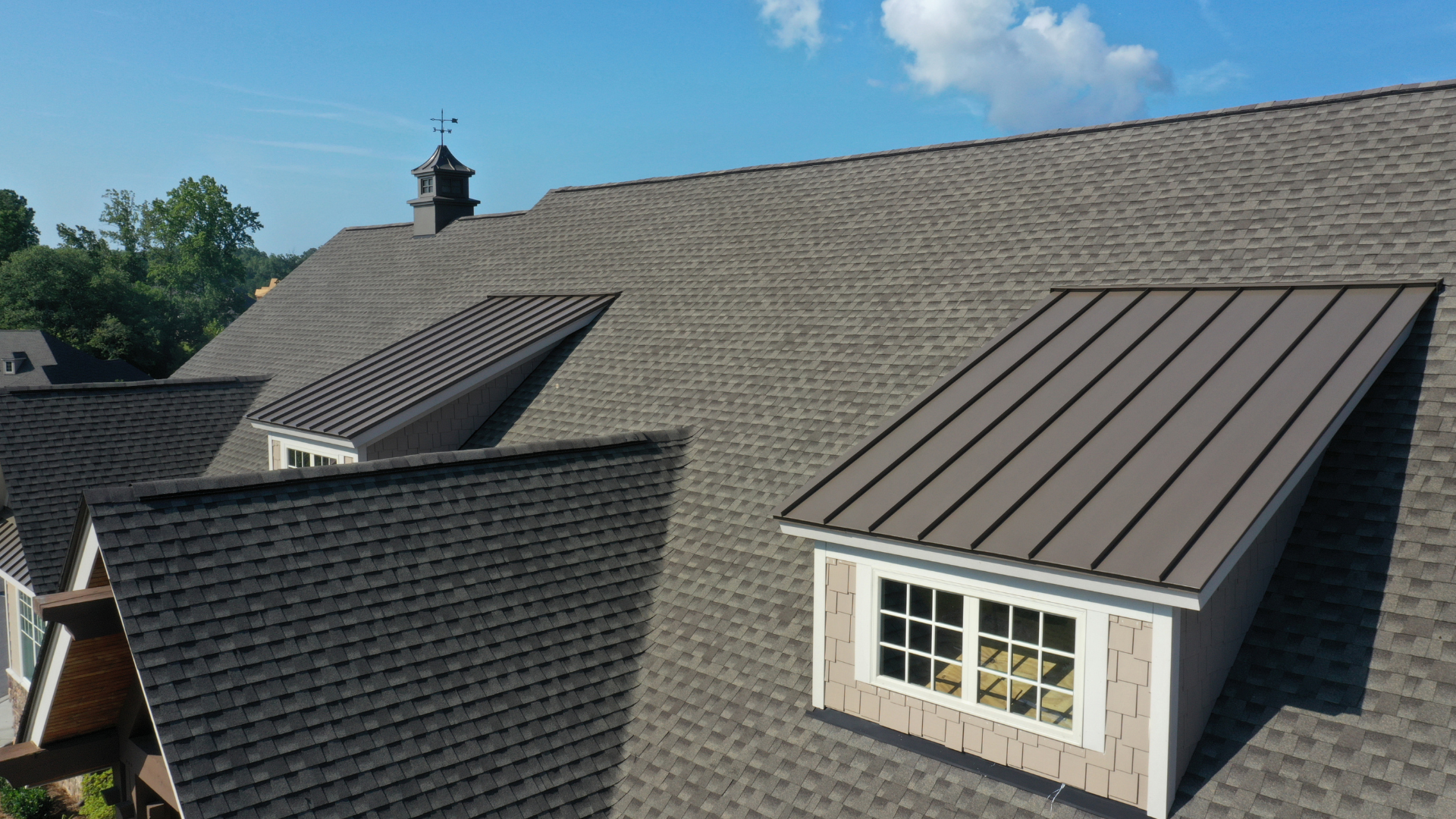Roof Repair Tips for Older Homes in Rosemount, MN Roof Repair Tips for Older Homes in Rosemount, MN Owning an older home …
Top Causes of Roof Leaks in Minnesota Homes and How to Address Them
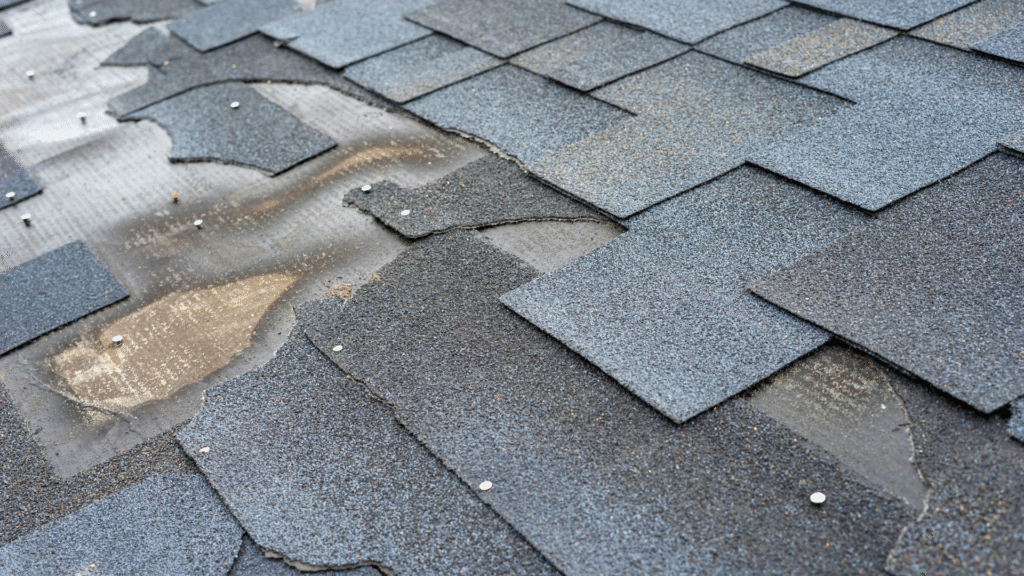
Top Causes of Roof Leaks in Minnesota Homes and How to Address Them
Minnesota’s weather can be harsh and unpredictable. From heavy snow and ice to spring thunderstorms and summer hail, our roofs take a beating year-round.
Unfortunately, all that exposure can lead to one of the most common homeowner headaches: roof leaks.
At Specialty Work Services, we help homeowners across Minnesota tackle leaks quickly and effectively. In this guide, we’ll break down the most common causes of roof leaks and explain how you can address them before they cause major damage.
Whether you’ve already noticed a drip or just want to stay prepared, this article will give you the information you need to protect your home.
Why Roof Leaks Happen in Minnesota
Roof leaks often start small, but left untreated, they can lead to expensive repairs.
Understanding what causes leaks helps you catch problems early and prevent bigger issues down the road.
In Minnesota, we see a few causes pop up more than others. These include:
- Extreme temperature changes
- Ice dams and heavy snow loads
- Hail and windstorms
- Poor roof installation or aging materials
- Clogged gutters
- Flashing failures around chimneys, vents, and skylights
Each of these factors presents unique challenges — and requires specific solutions to protect your home.
1. Ice Dams and Snow Accumulation
One of the most notorious winter problems in Minnesota is ice damming.
Ice dams form when snow melts on your roof, trickles down to the colder eaves, and then refreezes. As the ice builds up, it traps water behind it, which can seep under shingles and leak into your attic and walls.
Signs of ice dams include:
- Large icicles hanging from gutters
- Water stains on ceilings or walls during winter
- Areas of the roof where snow melts unevenly
If you notice these warning signs, it’s important to act quickly.
Solutions to prevent ice dams:
- Improve attic insulation to prevent heat loss
- Ensure proper roof ventilation to maintain even roof temperatures
- Safely remove snow buildup using a roof rake
- Call a professional to install ice and water shield membranes or heat cables
Preventing ice dams is one of the best ways to keep winter roof leaks at bay.
2. Damaged or Missing Shingles
High winds, hail, and normal aging can crack, loosen, or completely remove shingles from your roof.
When shingles are missing or compromised, your roof’s underlayment becomes exposed to the elements. This makes your home much more vulnerable to leaks.
How to spot damaged shingles:
- Look for shingles in your yard after a storm
- Check your roof for patches that look uneven or bare
- Watch for granule loss in gutters, which signals aging shingles
It’s a good idea to inspect your roof after any major weather event.
Solutions for damaged shingles:
- Replace missing or damaged shingles promptly
- Schedule regular roof inspections, especially after storms
- Consider upgrading to impact-resistant shingles designed for Minnesota’s tough weather
A little maintenance now can prevent major water damage later.
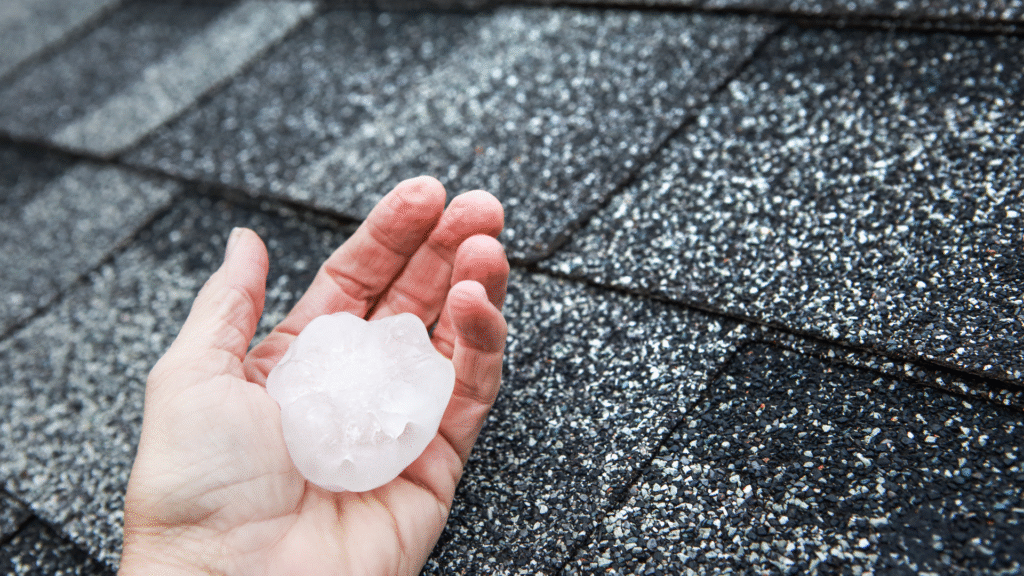
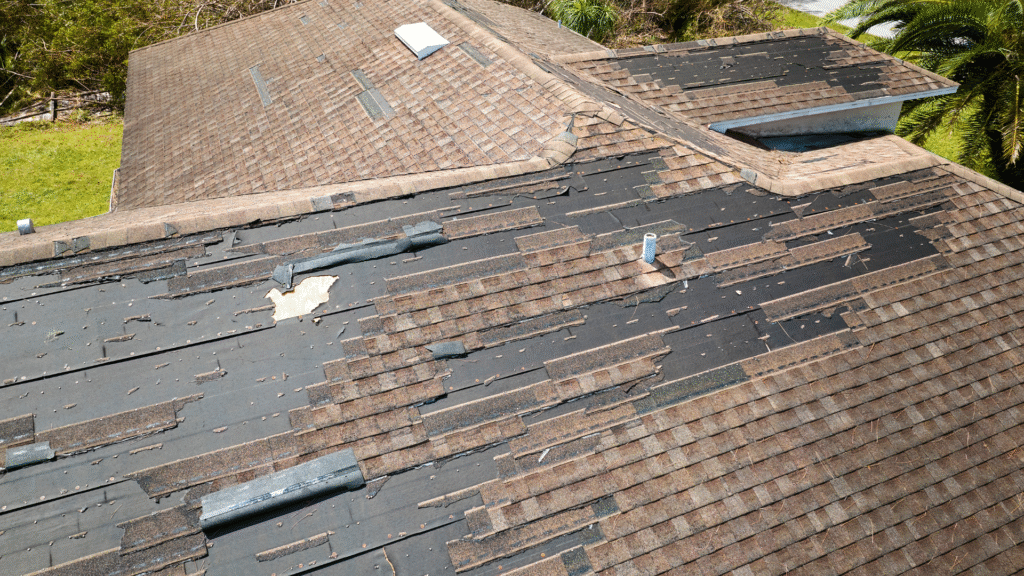
3. Flashing Failures
Flashing is the metal installed around chimneys, vents, skylights, and valleys to direct water away from critical seams.
Over time, flashing can crack, corrode, or pull away from the roof, leading to leaks around these vulnerable areas.
Warning signs of flashing problems:
- Water stains around your chimney or skylights
- Rusty or visibly lifted flashing
- Dripping water near roof penetrations during rainstorms
When flashing fails, water quickly finds its way inside.
Solutions for flashing issues:
- Seal minor gaps with roofing caulk as a temporary fix
- Replace damaged flashing with professional-grade materials
- Hire a pro to ensure flashing is installed with a watertight seal
Proper flashing is essential for a leak-free roof.
4. Clogged Gutters and Downspouts
Gutters and downspouts play a major role in protecting your roof and home from water damage.
When they become clogged with leaves, debris, or ice, water backs up and can seep under your shingles, causing leaks along the eaves.
Common indicators of gutter problems:
- Overflowing gutters during rainstorms
- Water pooling around your home’s foundation
- Visible plant growth in your gutters
If you see these signs, it’s time to take action.
Solutions for clogged gutters:
- Clean gutters at least twice a year, ideally in spring and fall
- Install gutter guards to reduce debris buildup
- Check downspouts for clogs and ensure they direct water away from your home
Maintaining your gutters is a simple but powerful way to prevent leaks.
5. Aging Roof Materials
Even the best-installed roofs don’t last forever.
As roofing materials age, they naturally weaken and lose their ability to shed water effectively.
Signs your roof may be aging include:
- Curling, cracking, or brittle shingles
- Bald spots where shingle granules have worn away
- Sagging rooflines or soft spots when walked on
An old roof is an open invitation for leaks.
Solutions for aging roofs:
- Replace your roof when it nears the end of its expected lifespan (typically 20–30 years)
- Schedule annual inspections to catch early signs of wear
- Invest in high-quality roofing materials for your next replacement
Catching aging issues early can save you thousands in repairs.
What to Do if You Notice a Roof Leak
If you spot signs of a leak, it’s critical to act quickly.
Every hour you wait increases the risk of water damage, mold growth, and costly structural problems.
Immediate steps to take:
- Contain any dripping water with buckets or towels
- Move furniture and valuables out of the affected area
- Document the damage with photos for insurance purposes
- Call Specialty Work Services for a professional roof inspection and repairs
Temporary DIY fixes are helpful, but permanent repairs must be handled professionally.
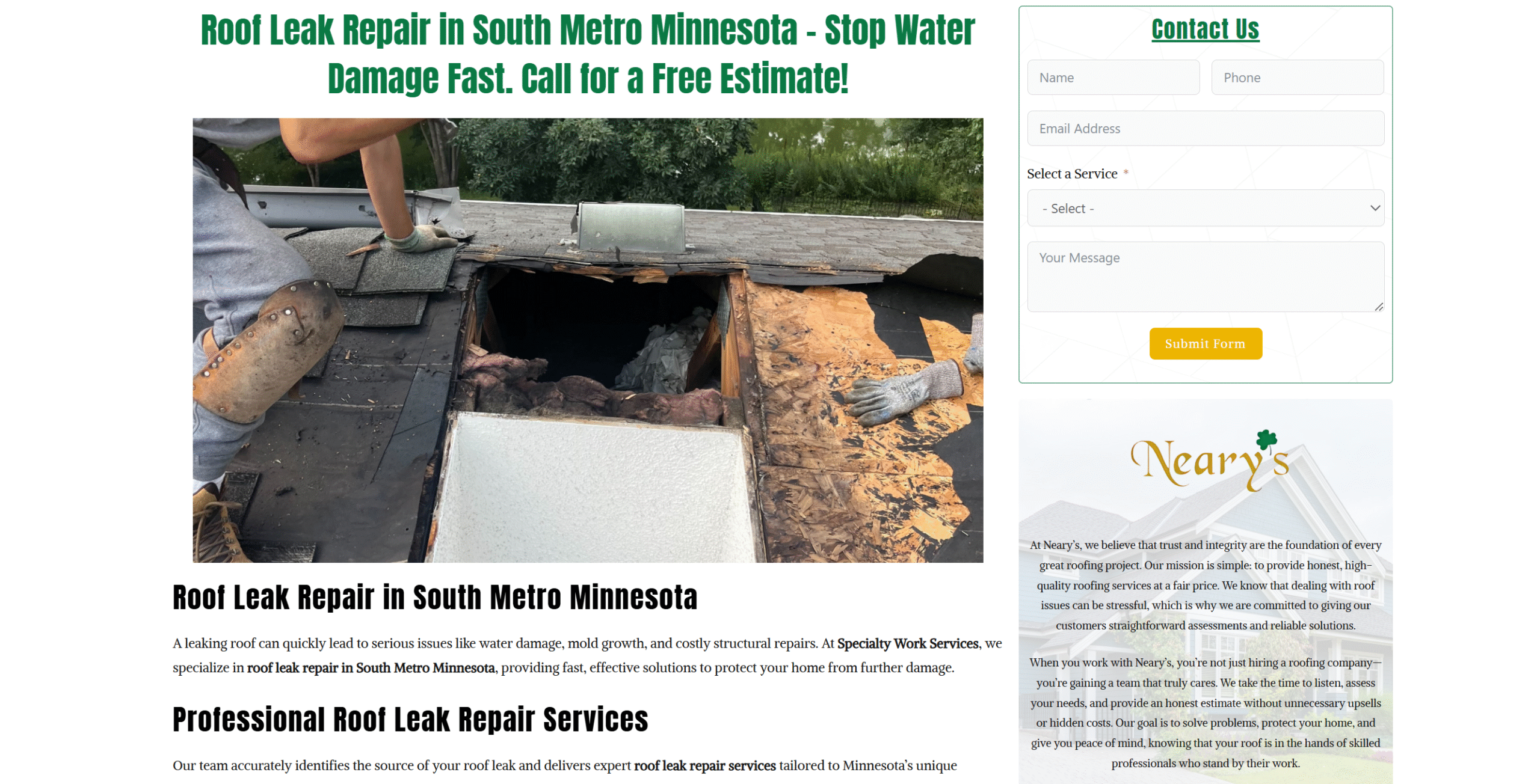
How Specialty Work Services Can Help
At Specialty Work Services, we specialize in diagnosing and repairing roof leaks quickly and effectively.
Here’s why Minnesota homeowners trust us:
- Fast emergency response for urgent leaks
- Detailed roof inspections and damage assessments
- High-quality repair and replacement materials
- Expertise in handling insurance claims
- Focused on long-term solutions, not just quick patches
We proudly serve homeowners throughout the Twin Cities, surrounding suburbs, and greater Minnesota.
No matter the season, we’re ready to protect your home from leaks.
Roof Leak Prevention Tips
While you can’t control Minnesota’s weather, you can protect your home with a few smart steps.
Simple prevention tips include:
- Schedule annual roof inspections to spot issues early
- Clear gutters and downspouts regularly
- Trim trees that overhang your roof
- Add attic insulation and ventilation upgrades
- Replace worn-out roofing materials promptly
Preventive care today means fewer emergencies tomorrow.
Final Thoughts
Roof leaks are a common headache for Minnesota homeowners, but they don’t have to become a major disaster.
By understanding the top causes—and addressing them quickly—you can protect your home, your wallet, and your peace of mind.
If you suspect a leak or want to prevent future problems, trust the experts at Specialty Work Services.
We’re here to help you every step of the way with fast, professional service you can rely on.
Contact Us
Specialty Work Services Roofing Company provides expert roofing solutions—contact us today for reliable service and a free estimate!






Why Rosemount, MN Homeowners Are Seeing More Roof Leaks in Spring 2025 Why Rosemount, MN Homeowners Are Seeing More Roof Leaks in …
DIY vs. Professional Roof Leak Repairs: What Homeowners Need to Know DIY vs. Professional Roof Leak Repairs: What Homeowners Need to Know …
Understanding the Lifespan of Asphalt Shingles in Minnesota’s Climate Understanding the Lifespan of Asphalt Shingles in Minnesota’s Climate When it comes to …

